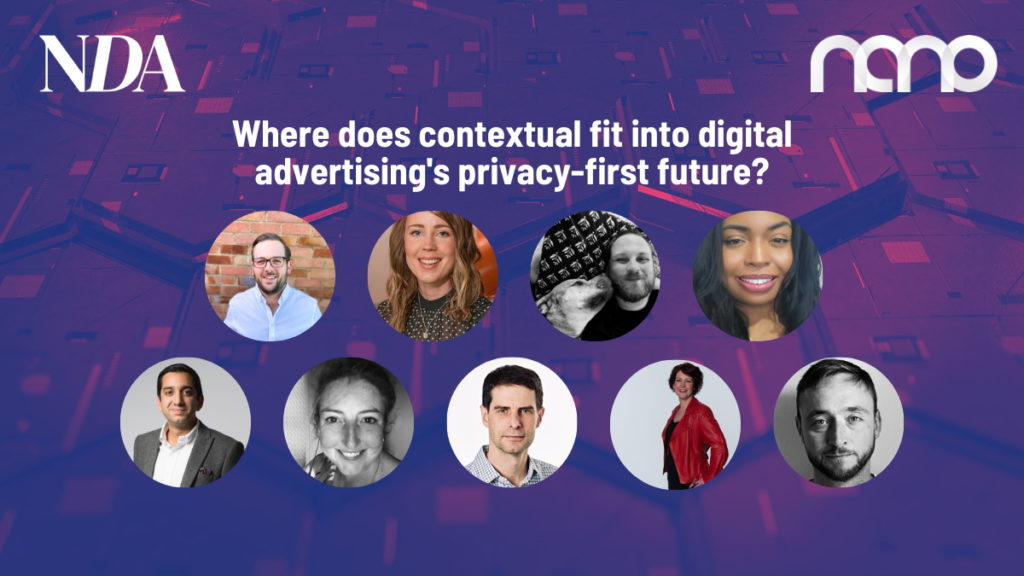As we slowly head toward the deprecation of third-party cookies on Google’s Chrome browser, the digital advertising industry is exploring a range of solutions to replace its reliance on cookies. Alongside the use of first-party data, there has been a lot of talk about contextual advertising, and how advances have made it a truly viable solution. So, what role does contextual have to play in the future of digital advertising?
In the second part of our roundtable, in partnership with Nano Interactive, our panel of experts dive deeper into the topics of contextual advertising and measurement. Chaired by NDA’s Editorial Content Manager Michael Feeley, the roundtable featured Alex Newberry, Chief Revenue Officer, Content Ignite; Chloe Nicholls, Head of Ad Tech, IAB UK; Angus Deuchar, Client Development Lead, Performics; Faisal Karmali, Senior Director, International Business Operations, CNN International Commercial; James Northway, Global Head of Data, Wavemaker; Micarla Joseph, Senior Director, Buying, M&C Saatchi Performance; Natascha Chamuleau, Chief Advertising Officer, WeTransfer; George Lintott, Client Product Partner, Dentsu UK&I; and Heather Lloyd, Head of Product Marketing, Nano Interactive.
Nano’s Lloyd acknowledges that contextual won’t be the only approach taken, pointing out the importance that first-party data will have. However, first-party data struggles when it comes to scale, and that’s where contextual comes in.
“There’s always going to be a scalability issue there, and that’s where something like contextual will be important across the board. You’re going to need something to plug that gap,” said Lloyd
“We’re far away from contextual as we used to think of it. Now, we can understand content down to a sentiment level, and understand what that means from a user perspective. If it’s a positive piece of content, or if it’s a negative piece of content, how does that help us understand the user mindset? How does that help us optimise? We see better clickthrough rates on positive content, versus negative content, for example. What does that tell us? So, contextual is almost limitless at the moment.”
Wavemaker’s Northway was equally keen to point out how far it’s possible to go with contextual in this day and age. He said: “What we’re all thinking in our heads right now is how we use the information on the page. But there’s also the wider thing of what time of day it is, what the weather is like outside, where the consumer is, if they’re travelling – there are lots of other contexts wrapped around. What are you reading, interacting with, or listening to? It adds to the depth of it, so there’s a huge amount of scope.
“We’re very used to thinking about audiences, and describing them, in behavioural or demographic ways. But, with contextual, you can start to think about emotion and sentiment.”
At M&C Saatchi, Joseph is seeing more “overt interest” in contextual advertising, with the agency becoming increasingly keen to test contextual.
“The testing elements of it is something that we are exploring a lot more,” said Joseph. “In the past, the focus was on contextual in the sense of the site relevance to the user. But there’s also the brand relevancy, the creative relevancy, the content on the site. So, there are so many different testing elements that, once our algorithms start to open up those data points, we’ll be able to access a lot more. And that’s where the interest will definitely increase a lot more as well.”
With all the possibilities that modern contextual is capable of delivering, there’s a question whether we should still be calling it ‘contextual’ – and IAB UK’s Nicholls thinks there is a possibility that could one day happen.
“Once you’re tied to a certain definition or way of looking at something, it’s difficult to move away from that. And, in some ways, it’s easier to continue calling it contextual,” she said. “But defining it and naming it something different could be possible as it does evolve, especially in terms of how it’s being fuelled by the AI behind it as well.
“I think it’s a really good opportunity with contextual for advertisers who are cautious to use personal data, as well as giving them that scale and reach for their advertising.”
WeTransfer’s Chamuleau believes that, whatever name we give it, the role of creativity in contextual is something that should be considered of importance. Alongside this, she feels that the digital advertising industry needs to be more aware of the role it all plays in the physical world.
“We’re very hyper-focused on creativity, but I do think it all works together. It’s a combination of user relevancy and creative relevancy. That is becoming more and more important,” said Chamuleau.
“But also, what we also see slowly developing is that it’s not standalone digital campaigns anymore – it’s much more integrated in a broader setup. It’s integrating the physical worlds and the digital worlds together. That’s also benefiting from contextual advertising and shared moments to really bring that closer together. Sometimes, being in the digital space, we forget about what’s happening out there.”
Context is king for publishers
Content Ignite’s Newberry is seeing contextual become “more important” to smaller publishers that might not have the resources to utilise first-party data effectively
“From my point of view, I represent independent publishers. We know that publishers’ first-party data is going to be their strength moving forward, but there’s a whole swathe of publishers that don’t have the money to track their first-party data properly, or segment it, or even offer it to buyers,” Newberry explained. “Contextual is probably the only tool offering those publishers any sort of sales story, understanding of their audience, or ways to deliver their audience in a way that buyers might prefer.”
However, even larger publishers are reaping the rewards when it comes to contextual, with CNN International’s Karmali keen to point out that contextual, in some instances, outperforms behavioural.
“Contextual is probably more immediate than behavioural now, because it’s literally the context of what they’re trying to read, it’s the subject matter,” he said. “We’ve found that sometimes our contextual segments outperform our behavioural segments. That’s been the approach, with sentiment on top. And, as a news organisation and a publisher of other content as well, it’s been a super useful tool to come back. After 10 years, we’ve been forced to use it again, but the performance has been great.”
Can I have your attention please?
To ensure that everything is able to work, the industry needs to be moving toward some form of common metric, according to Dentsu’s Lintott.
“One thing we need is some sort of common taxonomy or metrics that we’re all using,” he said. “Obviously, we’re moving toward this attention-based economy, which is fantastic. Sometimes, some of the smaller publishers need there to be that consistency, which ad tech does provide. Otherwise, it’s too fragmented for big media buyers to incorporate everything, and that doesn’t work operationally.”
One the other hand, Performics’ Deuchar believes it’s wishful thinking that the industry will be able to find common ground, because “each brand is going to evolve differently, move differently, and mean different things”.
“Honestly, finding a new common currency is going to be, if not impossible, super unlikely. So, actually, what we’re looking at here is a really interesting diversification of how we measure, which is brilliant, because that’s much more exciting,” said Deuchar.
“The winner in this space will be the ad tech that can drive their currency back to business outcomes. Because, ultimately, that will always be the common currency for marketing. Attention is great, because it’s a great proxy, but you’re never going to be able to present an Excel spreadsheet showing the amount of attention you drove.”










